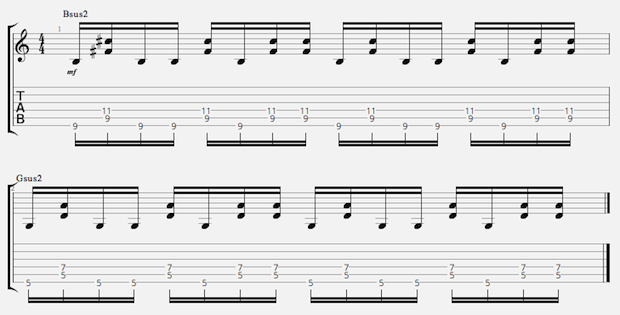Musical Fluency: Stealing From Drummers — Single Paradiddle

When you’re running low on ideas, a great place to turn for inspiration is other instruments. Learning a sax lick, a piano chord voicing or a vocal melody can allow you to approach music from an entirely new angle.
Getting a peek at how other instrumentalists think also can help you get in sync with your bandmates.
If you know what your bass player is trying to do, then you can complement his basslines better with your guitar part. If you understand your drummer’s fills, you can strum along in a way that matches or accents his drum parts.
In this post, we’re going to check out a common rhythmic pattern used by drummers called the single paradiddle. Then we'll look at how you can use this sort of pattern to come up with new ideas on the guitar.
Single Paradiddle
The single paradiddle is an example of what’s known as a drum rudiment. Guitarists practice chord changes and scale runs; drummers practice rudiments. They’re basic drum-stroke patterns that are learned on one drum and can then be applied to different drums or used in a beat.
The single paradiddle follows this pattern of right-hand (R) and left-hand (L) drum strokes:
All the latest guitar news, interviews, lessons, reviews, deals and more, direct to your inbox!
R L R R L R L L
You can even say the word “paradiddle” twice along with the pattern to help you get a feel for the rhythm. Para-diddle para-diddle.
OK, so how does this help us out on the guitar? Let’s take a look at just a few possibilities.
Riff Rhythm
One way to use the paradiddle pattern on the guitar is to develop accented rhythms for guitar riffs. For example, let's assign each drum stroke to a string or set of strings. For every right-hand stroke in the paradiddle pattern, hit the sixth string. For every left-hand stroke, hit the fifth and fourth strings together.
Let’s take this new paradiddle picking and apply it to just a couple of chords to see how it sounds. Here’s an example in drop D tuning using Bsus2 and Gsus2 chords.

If this sounds familiar, it may remind you of “Everlong” by the Foo Fighters, which uses a similar rhythm with these types of chord voicings. Since Dave Grohl is a drummer, it makes sense that he would look at the guitar as if the strings are different drums on a kit.
Lead Licks
Now let’s take the same idea of assigned different drum strokes to different strings, but apply it to a lick on the top two strings. The right-hand stroke becomes the 2nd string, and the left-hand stroke becomes the first string.
Here’s an example in the key of B minor, with a couple of slides thrown in to give the lick a smoother sound.

Getting Creative
There are so many more uses for this basic single paradiddle rhythm. The idea is to think of the pattern as just A-B-A-A, B-A-B-B, where the A’s and B’s can stand for anything that you want.
Like we’ve done in this post, the A could be one string and the B another. Or you could create fingerpicking patterns. The A could stand for one finger in your plucking hand, while B stands for another finger or group of fingers.
Or you could make the A’s and B’s stand for two different notes in a scale or arpeggio. The possibilities really are endless, so see what you can come up with!
Ben Rainey works as a guitar teacher and freelance guitarist in the Pittsburgh area. He's also in charge of music content at Tunessence.com.
